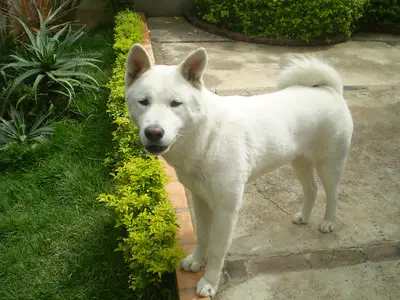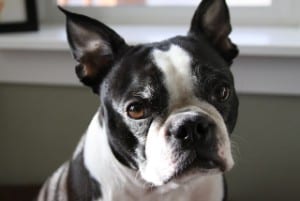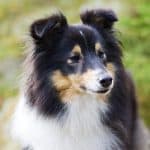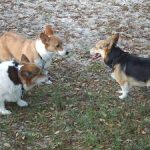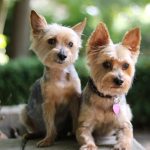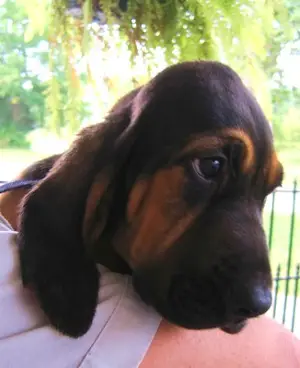
Every dog possesses an occipital bone.
However, you may have noticed that some breeds have more noticeable occiputs than others. Why is that, and which breeds have the largest occiputs?
Slow-down cowboy!
Before we address these intriguing questions, we must first review what an occiput is.
What is an occiput?
Have you noticed a curious bump atop your dog’s head?
That, my friend, is an occiput. In Latin ob translates to “against,” and capit means “head.”
Together “ob” and “capit” have metamorphosed into the modern English word occiput.
As the Latin root suggests, occiput refers to the rear of the head or skull.
Humans and furry friends alike have occiputs (that’s right, you have an occipital bone, too!).
For us two-legged, upright standing creatures, the occiput is located on the lower back of the skull, which is probably why you haven’t given yours much thought.
While humans have subtle occiputs, this is not always true of our four-legged companions, many of which have protruding occiputs.
If you notice that your dog’s occiput is increasing in size, check out our blog entitled “Why is My Dog’s Occupit Getting Bigger?”
Why do dogs have occiputs?
So … what’s up with that weird bump on the back of your dog’s head?
Well, nature is no amateur.
Though people once thought the occiput was an indicator of a dog’s intelligence, we now know that evolutionarily, occiputs served a very important purpose for the little wolves we lovingly call dogs today.
This rear bone protected their brains from potentially fatal bites from predators’ sharp teeth.
The occipital bone inhabits prime real estate by buffering access to a dog’s skull, and this cushion could have very well spared the lives of your pup’s ancestors way back when.
The occiput, put simply, was a means of protecting your dog in a doggy-dog world.
Pun-intended!
What dog breeds have a large occiput?
The characteristics we see in dogs today are relics of dogs’ evolutionary forbearers, wolves.
Hard to believe as this may be, adorable Chihuahuas and formidable German Shepherds share a common ancestor.
The diversity between dogs is mind-boggling, with different breeds possessing variations in skull shape, size, behavioral qualities, and more.
However, certain traits in dogs appear to go hand in hand.
For example, researchers have discovered a positive correlation between occipital width and body mass in several mammals, meaning that a protruding occiput is a predictor of greater body weight.
If we extrapolate this finding to dogs, it suggests that the larger the dog, the greater likelihood of a more prominent occiput.
In this light, perhaps it should be no surprise that sporting dog breeds tend to have the most discernable occiputs.
One by one, we are going to delve into specific breeds with large occiputs.
Bloodhounds
The droopy eyes and ears of the bloodhound bestow this noble steed with a wise appearance, as if you had set eyes on Aristotle’s soul incarnated into your furry friend. The creases that tend to form above this breed’s eyes similarly impart an illusion that the bloodhound is as old as time. You will notice that atop this breed’s narrow, oval-shaped head exists an unmistakable bump. Given that bloodhounds are endowed with qualities that would render them top-notch hunters, perhaps evolution sensibly granted this breed a generous occiput.
Aggressive as the name “bloodhound” may ring, don’t let this title fool you. Bloodhounds are known to be gentle, affectionate, and even-tempered. Though stubborn, it is impossible not to swoon when you observe a bloodhound exuding admirable patience with a child who tries to climb him.
Fun fact: did you know that bloodhounds are estimated to possess upwards of 200 million scent receptors, surpassing the olfactory ability of all their dog counterparts?
Labrador Retrievers
Equipped with a wide brow, you might notice a wider, more rotund occiput hugging the head of this lovable breed. Advertisers have long discovered the irresistible charm and photogenic potential of this handsome breed. And can you blame them? Just one look at this pup’s youthful eyes and playful spirit and you will be uplifted.
Historically, Labrador Retrievers were gun dogs, a term that describes dogs that assisted humans in hunting and retrieving prey (hence the name of this breed!). Given Labrador Retrievers’ many years of cooperating with humans, it is no wonder that this intelligent and cooperative breed is known to be “man’s best friend.”
Fun fact: Did you know that Labs were made for water? More than being a figure of speech, this breed’s physiology – such as thick tails, webbed feet, and water-resistant coat – predisposes them to enjoy swimming.
Golden Retrievers
On the rear of the Golden Retriever’s skull is a mound that resembles a modest sand dune. It’s none other than this breed’s occiput, which endearingly, looks like a little, circular crown centered upon the Golden Retrievers’ head. This breed’s lustrous golden tresses, floppy ears, and feathering on the back of the legs, under the belly, and in front of the neck, render the Golden Retriever a sight for sore eyes. Not only are Golden Retrievers outwardly attractive, but they also possess many redeemable personality traits.
Golden Retrievers are said to be friendly, in addition to extremely loyal. Like Labs, Golden Retrievers were also once gun dogs, and this might inform their athletic prowess, intelligence, and strong emotional tie to humans.
Fun fact: Golden Retrievers shed a lot!
English Setter
The English Setter is a moderately sized dog with a long, narrow bridge connecting its nostrils and cranium. You will notice that just before that delicate juncture where the skull meets the neckline is the English Setter’s protruding occiput, which might not be perfectly centered.
This breed is often multicolored and dusted with colorful speckles akin to human freckles. English Setters boasts an elegant look, with long droopy ears and a long, arched neck.
Notwithstanding the above dainty description of the English Setter, this breed was a hunting dog in England centuries ago (hence the “English” title).
You may catch an impish glimmer in this breed’s eyes, as English Setters are rumored to be mischievous and strong-willed. They are also described as amiable, gentle, and intelligent.
Fun fact: the word “Setter” in English Setter refers to the position this pup would take to indicate the presence of game to be hunted.
English Pointer
The English Pointer boats a lean, athletic body with long legs. This breed’s face tends to be bony, with traceable cheekbones and a pronounced occiput. As the name indicates, this breed was first apprehended in the United Kingdom in 1650. The second part of this breed’s name, “Pointer” refers to its early role to point out prey with their muzzles.
English Pointers are known to be independent, highly energetic pups that enjoy exercise and the great outdoors. This makes them apt companions for avid adventurers, regular joggers, and families with young kiddos bursting with energy. On the flip side, this breed might not be ideal for individuals who are sedentary and averse to greenery. English Pointers are thought to be trainable, intelligent, alert, and devoted.
Fun fact: Apparently, this breed can display hunting instincts at the ripe age of two months old!
English Cocker Spaniel
Spaniels in general, and particularly English Cocker Spaniels, have quite a conspicuous occiput. This breed has a long face, and the occiput sits proudly at the tippy top. As you caress the soft and silky hair of a Cocker Spaniel, give this breed’s occiput special attention. The American Kennel Association reveals that massaging dogs marinates them with mental, physical, and emotional health dividends, and canine practitioners believe that the region of the occiput has many nerve endings.
Cocker Spaniel’s uniquely long and droopy ears are a hallmark feature that makes them easy to identify. Their thick hair and Goldilocks – not too big, yet not too small – size make them perfect cuddle buddies.
English Cocker Spaniels are traced back to the United Kingdom and they too were hunting dogs (are you sensing a motif here?). This breed is reported to be all-around wonderful – affectionate, alert, playful, cooperative, and active.
Fun fact: Did you know that dogs can detect cancer via scent? As nuts as it may sound, a 2004 study conducted in England confirmed this to be so. In that study, a Cocker Spaniel was most adept at sniffing cancer.
Bassett Hound
Last but not least, the Basset Hound, small as it might be, possesses quite an impressive occiput. This breed’s face is long and cone-like, and the occiput further elongates its face. This Basset Hound’s long ears resemble symmetric pigtails, and its long, cylinder-shaped body distinguishes it from other breeds.
Researchers trace this breed to Belgium, which borders France. In French, “basset” means low, which is fitting given this breed’s short, stout legs. Basset Hounds are thought to be friendly, social, easy-going, and devoted. Some have attributed less flattering qualities such as laziness to them, but truthfully, this is probably a misunderstanding of this breed’s more relaxed, low-energy vibe.
Fun fact: This breed’s unique physical appearance assists it in smelling the world. For example, its long ears stir scents towards its nostrils, and the wrinkled skin on its face aids it in retaining the aromas within the crevices.
Closing Thoughts
Hopefully, this blog provided you with appreciation for the bump perched on your dog’s precious cranium. Understanding that our fur baby’s occiput evolved out of a very important purpose can move us to marvel at the miraculous intelligence and care that nature invested in our furry friends’ features.

